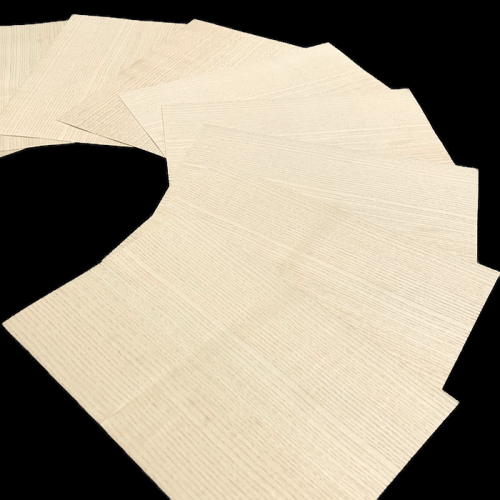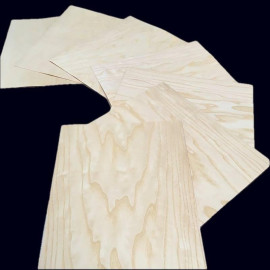
White Ash 0.3 mm Quarter-cut Small-size Veneers
White Ash 0.3 mm Quarter-cut Small-size Veneers
Genuine wood sliced-veneer sheets.
Selected single veneers, no sequence.
Fix length of 30 cm long.
Width: From 15 to 21 cm, depending on availability.
Thickness: 0.3 mm.
Sold by the sheet.
Warning: Carefully read the full description of these veneers.
White Ash 0.3 mm Quarter-cut Small-size Veneers
Genuine wood sliced-veneer sheets.
Selected single veneers, no sequence.
Warning:
0.3mm is twice thinner than the standard 0.6 mm thickness.
This thickness is ideal for making complex wrapping or using its translucency in lampshade craft.
Dimensions:
Fix length of 30 cm long.
Width: From 15 to 21 cm, depending on availability.
Thickness: 0.3 mm.
Sold by the sheet.
Measurement scaling:
The width is rounded to the covered centimeter, for example, 15.8 cm, giving 15 cm.
Species:
Common names:
Ash, Common ash, European ash, White ash (when the tree is large enough to develop brown heartwood).
Botanical name:
Fraxinus excelsior.
Origin:
France, Northern Europe in general, from the tip of Brittany to the Ural Mountains.
Appearance:
Ash is a light color and very homogeneous hardwood, except for olive/brown ash with contrasting veins.
Properties:
Density: 680 kg/m³, average weight at 10-12% moisture content.
Janka Hardness: 6580 N, for comparison: Oak is 4980 N and Poplar is 1650 N.
Modulus of elasticity: 12.31 GPa, for comparison: American maple 12.62 GPa and Poplar 9.75 GPa.
Bending strength: 51 MPa. For comparison, US maple is 109 MPa and Oak 47.3 MPa.
Uses:
It offers remarkable flexibility, justifying its use in diverse fields, such as tool handles, alpine/Nordic skis, skateboard or surfboard decks, bows and other sports accessories, gunstocks, automobile and naval construction, wagon making, and furniture.
From a decorative point of view, ash is an ideal wood for chamfering, with open-pored veins contrasting the wood with full veins.
It should be noted that ash is traditionally used for rubbing parts such as drawer slides. The more this wood rubs, the more it slides; it is "self-lubricating," so to speak.
Product Description:
Genuine wood-sliced veneer sheets.
These veneers are raw without a finish or any fleece back.
The veneer surface is similar to plane wood. However, it will be preferable to forecast a light sanding after gluing.
The veneers are offered here as wood-sliced sheets of one and unique thickness.
Both faces of these veneers are the same, without fleece back, without glue.
Even if the veneer's sides had been cut relatively straight, it isn't a precise parallel clipping; some veneers may have kept the decreasing shape of the tree, wider at the bottom end and narrower at the top end.
Very occasionally, some veneers' sides have traces of unclipped wane, but our veneers are measured at the narrowest, as explained in the paragraph "Dimensions."
As genuine natural wood, all finishing products are acceptable as long as they are meant for wood use.
The choice of the finished product must be consistent with the final usage realization.
Use of the veneers:
Cutting:
Veneers can be easily cut with a utility knife.
For straight cuts, the best results are obtained with a veneer saw.
Use a fretsaw, scalpel, or veneer knife for curved cuts.
Always allow for a slightly larger veneer sheet than your intended surface. This will allow you to adjust the size after gluing for a clean finish.
A flush trimmer can also be used to trim the veneer after gluing.
When cutting with a utility knife or veneer knife, it is best to cut with the grain of the wood. To check this, run your finger along the edge of the sheet. The direction that feels smoothest is the ideal direction for cutting.
Gluing:
Several types of gluing are possible.
With vinylic glue, the veneer is pressed over its entire surface.
With neoprene glue for all surfaces, especially non-porous surfaces, by applying two coats of glue and marouflage.
With animal glue such as hide, sinew, or bone glue.
With vinyl glue and an iron, apply two thin coats of glue to each piece. This technique should only be used if other gluing techniques are not possible.
Sanding:
Veneers and all our products are genuine wood and can be sanded according to their thickness.
Please do not use a belt sander, regardless of the thickness of the veneer, as this could pierce it.
With a 0.6 mm veneer, lightly sand with 120 grit and then finish with 180 or 240 grit. With an orbital sander, 180 grit is already sufficient for most applications.
Finishing:
All finishing products generally used for wood are suitable for finishing our products. For example, you can use a varnish, wax, paint, or oil.
However, ensure that the product you want to use is compatible with the final use of your creation.
Photos:
To keep the cost of these products as cheap as possible and contrary to other veneers on this website, the pictures of small-size veneers do not represent the available stock.
More information:
Please look at our TUTORIALS; you might find some valuable tips.
Please get in touch with us by email or phone for any additional information.
Data sheet
- Species
- Ash
- Thickness group
- Thin thickness
- Width group
- Standard width
- Grade
- Quarter-cut
You might also like
 English
English






